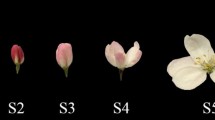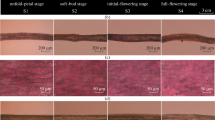Abstract
Key message
Compared with Magnolia biondii , higher anthocyanin content and higher expression level of related structural genes involved in flavonoids biosynthesis were detected in its variety M. biondii var. purpurascens .
Abstract
Magnolia plants are old species and have evolved a variety of flower colors. Color differences occur between Magnolia biondii (MB) and its variety M. biondii var. purpurascens (MBP). MB shows pink at the bottom and white at the top of petals, while MBP shows purple at the bottom and red at the top. To understand the underlying mechanism of color difference between these two Magnolia plants, the petal color phenotypic parameters, the composition and content of flavonoids, and the expression of related structural genes involved in flavonoids biosynthesis were compared and analyzed between MB and MBP. Generally, L* and b* values of MB were higher than those of MBP, and a* and C* values of MB were lower than those of MBP. Four anthocyanins and ten flavonols were identified in both MB and MBP. Total anthocyanin content (TA) in MBP was higher than that in MB at five developmental stages, while total flavonols content (TF) in MBP was higher than that in MB just at the soft bud stage. TA was significantly negatively correlated with L* value, but showed significant positive correlation with a* and C* values. Higher anthocyanin accumulation in MBP was related with high expression of many structural genes, but lower expression level of MbF3'H in MBP from soft bud stage to half blossom stage retards the increase of anthocyanins’ accumulation. These results will provide a foundation for revealing the underlying mechanism of color difference between MB and MBP, and understanding flower color evolution in Magnolia plants.




Similar content being viewed by others
Code availability
Not applicable.
References
Asen S, Stewart RN, Norris KH (1971) Co-pigmentation effect of quercetin glycosides on absorption characteristics of cyanidin glycosides and color of Red Wing azalea. Phytochem 10:171–175. https://doi.org/10.1016/S0031-9422(00)90266-8
Borghi M, Fernie AR, Schiestl FP, Bouwmeester HJ (2017) The sexual advantage of looking, smelling, and tasting good: the metabolic network that produces signals for pollinators. Trends Plant Sci 22:338–350. https://doi.org/10.1016/j.tplants.2016.12.009
Brown BA, Clegg MT (1984) Influence of flower color polymorphism on genetic transmission in a natural population of the common morning glory, Ipomoea purpurea. Evol 38:796–803. https://doi.org/10.1111/j.1558-5646.1984.tb00352.x
Brugliera F, Tao G, Tems U, Kalc G, Mouradova E, Price K, Stevenson K, Nakamura N, Stacey I, Katsumoto Y, Tanaka Y, Mason JG (2013) Violet/blue chrysanthemums-metabolic engineering of the anthocyanin biosynthetic pathway results in novel petal colors. Plant Cell Physiol 54:1696–1710. https://doi.org/10.1093/pcp/pct110
Buer CS, Muday GK, Djordjevic MA (2007) Flavonoids are differentially taken up and transported long distances in Arabidopsis. Plant Physiol 145:478–490. https://doi.org/10.1104/pp.107.101824
Castañeda-Ovando A, Pacheco-Hernández MDL, Páez-Hernández ME, Rodríguez JA, Galán-Vidal CA (2009) Chemical studies of anthocyanins: a review. Food Chem 113:859–871. https://doi.org/10.1016/j.foodchem.2008.09.001
Deng CY, Li S, Feng C, Hong Y, Huang H, Wang J, Wang L, Dai S (2019) Metabolite and gene expression analysis reveal the molecular mechanism for petal colour variation in six Centaurea cyanus cultivars. Plant Physiol Biochem 142:22–33. https://doi.org/10.1016/j.plaphy.2019.06.018
Heiss C, Keen CL, Kelm M (2010) Flavanols and cardiovascular disease prevention. Eur Heart J 31:2583–2592. https://doi.org/10.1093/eurheartj/ehq332
Heredia A, Heredia-Guerrero JA, Domínguez E (2015) CHS silencing suggests a negative cross-talk between wax and flavonoid pathways in tomato fruit cuticle. Plant Signaling Behav 10:e1019979. https://doi.org/10.1080/15592324.2015.1019979
Holton TA, Cornish EC (1995) Genetics and biochemistry of anthocyanin biosynthesis. Plant Cell 7:1071–1083. https://doi.org/10.1105/tpc.7.7.1071
Holton TA, Brugliera F, Tanaka Y (1993) Cloning and expression of flavonol synthase from Petunia hybrida. Plant J 4:1003–1010. https://doi.org/10.1046/j.1365-313X.1993.04061003.x
Jia N, Shu QY, Wang LS, Du H, Xu YJ, Liu ZA (2008) Analysis of petal anthocyanins to investigate coloration mechanism in herbaceous peony cultivars. Sci Hortic-Amsterdam 117:167–173. https://doi.org/10.1016/j.scienta.2008.03.016
Joshi CP, Chiang VL (1998) Conserved sequence motifs in plant S-adenosyl-L-methionine-dependent methyltransferases. Plant Mol Biol 37:663–674. https://doi.org/10.1023/A:1006035210889
Qian J, Lai W, Jiang L, Zhan H, Zhai M, Fu J, Zhang C (2021) Association between differential gene expression and anthocyanin biosynthesis underlying the diverse array of petal colors in Zinnia elegans. Sci Hortic-Amsterdam 277:109809. https://doi.org/10.1016/j.scienta.2020.109809
Shi SG, Yang M, Zhang M, Wang P, Kang YX, Liu JJ (2014) Genome-wide transcriptome analysis of genes involved in flavonoid biosynthesis between red and white strains of Magnolia sprengeri pamp. BMC Genom 15:706–706. https://doi.org/10.1186/1471-2164-15-706
Shi SG, Li SJ, Kang YX, Liu JJ (2015) Molecular characterization and expression analyses of an anthocyanin synthase gene from Magnolia sprengeri Pamp. Appl Biochem Biotechnol 175:477–488. https://doi.org/10.1007/s12010-014-1290-7
Shih CH, Chu H, Tang LK, Sakamoto W, Maekawa M, Chu IK, Wang M, Lo C (2008) Functional characterization of key structural genes in rice flavonoid biosynthesis. Planta 228:1043–1054. https://doi.org/10.1007/s00425-008-0806-1
Tanaka Y, Sasaki N, Ohmiya A (2008) Biosynthesis of plant pigments: anthocyanins, betalains and carotenoids. Plant J 54:733–749. https://doi.org/10.1111/j.1365-313X.2008.03447.x
Wang L (2019) The study of anthocyanin biosynthesis pathway in Magnolia wufengensis based on the high-throughput RNA-seq. Dissertation, Beijing Forestry University (in Chinese)
Wang Y, Li J, Xia RX (2010) Expression of chalcone synthase and chalcone isomerase genes and accumulation of corresponding flavonoids during fruit maturation of Guoqing No. 4 satsuma mandarin (Citrus unshiu Marcow). Sci Hortic-Amsterdam 125:110–116. https://doi.org/10.1016/j.scienta.2010.02.001
Wang YL, Ejder E, Yang JF, Kang YX, Ye W, Zhang SZ (2013) New varieties of Magnolia biondii and Magnolia cylindrica (Magnoliaceae) in China. Blumea 58:33–38. https://doi.org/10.3767/000651913X669707
Wang N, Lu D, Chang P, Bian S, Zhang C, Shen Y (2019a) Selection of internal reference genes in real-time quantitative PCR analysis of Magnolia biondii. Mol Plant Breeding 17:3674–3680 (in Chinese)
Wang N, Zhang C, Bian S, Chang P, Xuan L, Fan L, Yu Q, Liu Z, Gu C, Zhang S, Wang Y, Shen Y (2019b) Flavonoid components of different color Magnolia flowers and their relationship to cultivar selections. HortScience 54:404–408. https://doi.org/10.21273/HORTSCI13462-18
Xia N, Liu Y, Liu Y, Nooteboom NP (2008) Magnoliaceae. In: Wu CY, Raven PH, Hong DY (eds) Flora of China. Science Press, Beijing, pp 48–91
Yonekura-Sakakibara K, Nakayama T, Yamazaki M, Saito K (2008) Modification and stabilization of anthocyanins. In: Winefield C, Davies K, Gould K (eds) Anthocyanins. Springer, New York, pp 169–190
Yuan YW, Byers KJRP, Bradshaw HD (2013) The genetic control of flower-pollinator specificity. Curr Opin Plant Biol 16:422–428. https://doi.org/10.1016/j.pbi.2013.05.004
Zhang SZ, Wang YL, He ZC, Ejder E (2011) Genome differentiation in Magonoliaceae as revealed from meiotic pairing in interspecific and intergeneric hybrids. J Syst Evol 49:518–527. https://doi.org/10.1111/j.1759-6831.2011.00164.x
Zhang C, Wang WN, Wang YJ, Gao SL, Du DN, Fu JX, Dong L (2014) Anthocyanin biosynthesis and accumulation in developing flowers of tree peony (Paeonia suffruticosa) ‘Luoyang Hong.’ Postharvest Biol and Technol 97:11–22. https://doi.org/10.1016/j.postharvbio.2014.05.019
Zhao DQ, Tang WH, Hao ZJ, Tao J (2015) Identification of flavonoids and expression of flavonoid biosynthetic genes in two coloured tree peony flowers. Biochem Biophys Res Commun 459:450–456. https://doi.org/10.1016/j.bbrc.2015.02.126
Funding
This research was funded by the 13th Five-Year-Plan for Floriculture Special Breeding of Zhejiang Province, China (2016C02056-12), the Key R&D Project of Shanghai Science and Technology Commission (20dz1203700).
Author information
Authors and Affiliations
Corresponding authors
Ethics declarations
Conflict of interest
The authors declare that they have no conflicts of interest.
Additional information
Communicated by Braeutigam.
Publisher's Note
Springer Nature remains neutral with regard to jurisdictional claims in published maps and institutional affiliations.
Supplementary Information
Below is the link to the electronic supplementary material.
Rights and permissions
About this article
Cite this article
Wang, Nh., Dai, My., Zheng, G. et al. Flavonoid components and gene expression analysis reveal flower pigmentation difference between Magnolia biondii and its variety M. biondii var. purpurascens. Trees 36, 583–591 (2022). https://doi.org/10.1007/s00468-021-02231-7
Received:
Accepted:
Published:
Issue Date:
DOI: https://doi.org/10.1007/s00468-021-02231-7




